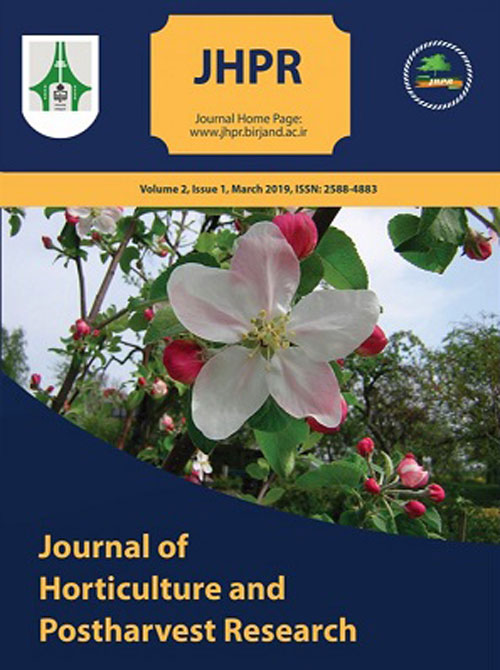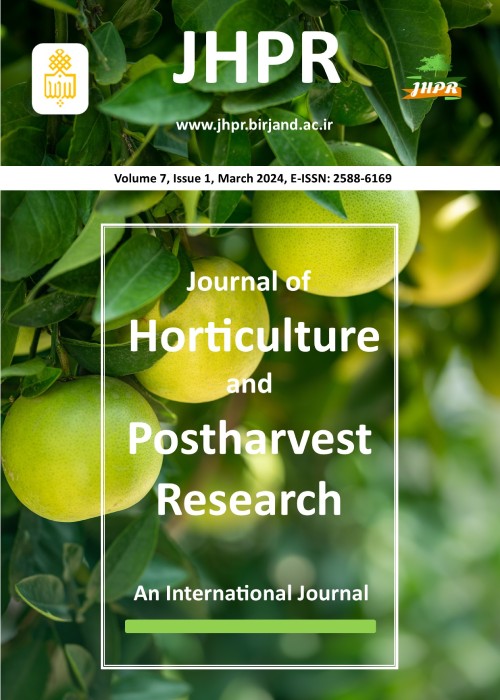فهرست مطالب

Journal of Horticulture and Postharvest Research
Volume:2 Issue: 1, Jun 2019
- Special Issue - POSTHARVEST LOSSES OF HORTICULTURAL CROPS
- تاریخ انتشار: 1398/03/11
- تعداد عناوین: 6
-
Pages 1-14PurposeThis study was conducted to identify and quantify the main causes and sources of losses in the tomato postharvest chain from harvest to retail market and identify appropriate interventions for reducing these losses in Nigeria, Rwanda and India.Research methodModified Commodity Systems Assessment Methodology on tomato was conducted in the study area during the July - August 2017 harvest season.FindingsGenerally, production is increasing with high postharvest losses. Tomato postharvest losses were uniformly high on the farm during harvest but generally lower during marketing in India than in Rwanda or Nigeria. Nigeria loses 10-40% of tomato produced from the farm to the retail market due to poor handling and unavailability of storage facilities. In Rwanda, tomato losses were exceedingly high, reaching 50 to 60%. These losses begin with the use of poor quality seeds to rough handling and use of inappropriate packaging materials. Losses in India varied between 1-18% mainly due to pest and disease attack and low price realization during glut season. However, in India, improved practices have been widely adopted on farm to retail market.LimitationsResources were limited, so a single two week time period were randomly selected to conduct each of the studies which focused on one state, district or region, so data cannot be used to describe losses for the entire country. Originality/Value: These studies identified priority tomato postharvest problems, key issues that currently limit market access, earnings for small farmers and rural marketer, training and advocacy issues for the three countries.Keywords: fruit vegetables, handling, postharvest losses, quality, value chain
-
Pages 15-26PurposePomegranate fruit is highly susceptible to water loss and chilling injuries during postharvest cold storage. Thus an experiment was conducted to evaluate the effects of modified atmosphere packaging on pomegranate shelf life and chilling resistance under cold storage.Research methodTreatments were vacuum packed and unpacked fruits (control) that were stored in a cold room at 5 ± 0.5 °C and 80 ± 5% RH. At the end of each storage period (30, 40, 50, 70, 90 and 130 days), packed fruits were assessed for physicochemical and quality parameters while control fruit were assessed after 90 days of storage.FindingsResults showed that packaging improves TSS/TA, and some color attributes, and decreased anthocyanin, total acidity, weight loss, electrolyte leakage, chilling injury index and unmarketable fruits. Evaluation of traits in different durations showed that vacuum packaging significantly reduced weight loss, electrolyte leakage, chilling injury index, and interestingly decreased the number of unmarketable fruits by 30%, compared with control. Anthocyanin contents significantly decreased since day 70 of storage. The a* and chroma values of peel significantly increased in packaging treatments as storage period progressed, however, hue value significantly decreased, compared with control.Research limitationsThere was no significant limitation to report. Originality/Value: The results suggest that bulk vacuum packaging can be used for up to 3 months to successfully alleviate chilling injury, reduce weight loss and the postharvest losses, and to extend the storage life of pomegranate fruit during cold storage.Keywords: chilling injury, modified atmosphere packaging (MAP), Punica granatum, weight loss
-
Pages 27-38PurposeSince most cut flower consumers do not have knowledge as to how to extend the post-harvest life of the cut flowers, the cut flowers purchased by them last for a very short time. The present study aimed to evaluate the people’s awareness as to cut flowers and the extent to which they consume and keep these flowers in Gorgan, Iran.Research methodThe sample size was determined to be 267 individuals by the Cochran formula. Considering the research objectives, 13 questions were developed within a questionnaire.FindingsThe results showed that 34.1 percent of respondents had no knowledge as to the cut flowers. Among the studied parameters, the cost was the second most important factor in flower choice after interest. Among respondents, 55.1 percent asserted that advertisement and promotion methods were effective on flower consumption. Also, 77.9 percent stated that they only used water to keep flowers and just a little percent added compounds to water.Research limitationsEvaluation of people from more cities in Iran. Originality/Value: It was found that flower consumption was not in a good state and people in Gorgan, Iran did not have enough knowledge as to the cut flowers and how to keep them and it was far from the ideal situation. To enhance people’s knowledge and improve their vision, it is necessary to perform training and extension works by the relevant officials.Keywords: Cut flowers, Gorgan, Postharvest, Vase life
-
Pages 39-48PurposeThe main objective of this work was to assess the effectiveness of potassium permanganate (KMno4), 1-methylcyclopropene (1-MCP) and different packaging on reducing the occurrence of decay and extending apricot fruit shelf life during cold storage.Research MethodFruits were harvested manually from a commercial apricot orchard based on peel color (light-green) and total soluble solids approximately 10.5 °Brix. Fruits were then dipped in KMnO4 (20 or 50 ppm) solution for 3 minutes or exposed to 1-MCP (0 or 1 µL L-1) for 20 h at 20 °C. Thereafter, fruits were placed into polyethylene trays and covered with cellophane films or polyethylene lid (packed with its lid) to create a passive modified atmosphere packaging, whilst the control group remained unpacked and then stored at 0.5 ± 0.5 °C with 80% RH.FindingsThe results showed that weight loss significantly reduced when apricot fruit covered with cellophane (10.02%) or when packed in PE containers (0.86%) compared to the unpacked control (37.61%), consequently, the firmness value was higher in unwrapped than wrapped fruit due to the high dehydration of unpacked fruit. Application of KMnO4 or 1-MCP had no significant effect on TSS. Interestingly, the shelf life extended 3-fold greater in treated fruit with KMnO4 at 20 ppm or 1-MCP (1 µL L-1) when packed in PE container compared to control unwrapped fruit.Research limitationsNo limitation to report. Originality/Value: In general, KMnO4 or 1-MCP treatments had a positive effect on fruit color and taste in packed samples on cellophane or PE container.Keywords: 1-MCP, KMnO4, MAP, organoleptic, Prunus armeniaca
-
Pages 49-60PurposeThe control of stored-grain insect pests is predominantly done through the use of synthetic insecticides. However, the extensive and constant (mis)use of these chemicals has brought complications that include faster evolution of resistant forms of pests, hence a global call for alternative control measures to reduce chemical applications. The aim of this research was to evaluate the repellent and toxic effects of E. citriodora leaf powder on adult P. truncatus and Sitophilus zeamais.Research MethodA completely randomized design was adopted in all the experiments. A choice test arena was set up to evaluate repellent effects of E. citriodora leaf powder on P. truncatus and S. zeamais. The toxic effect of E. citriodora was also evaluated, with untreated grain and conventional insecticides used as negative and positive controls, respectively.FindingsResults showed that E. citriodora leaf powder had repellent properties of up to 68.9% against both P. truncatus and S. zeamais populations. Nonetheless, low adult P. truncatus mortalities were recorded when the protective effects of the E. citriodora leaf powder (at the rate of 10% w/w) were tested against the beetle. Additionally, the efficacy of the synthetic insecticides was relatively higher when applied singly than when in combination with E. citriodora leaf powder.Research limitationsTime was the major limiting factor to consider other parts of E. citriodora plant (e.g. roots) on their usefulness in stored-product insect pest management. Originality/Value: Small plantations of E. citriodora may be established to offer a temporary grain protection against primary insect pests.Keywords: Prostephanus truncatus, Sitophilus zeamais, susceptibility, repellency, Eucalyptus citriodora
-
Pages 61-68PurposeDemand for tomato is increasing in Laos but marketing options are limited due to ripening during transit. This study quantified changes in fruit ripening during commercial transit to the major urban market in Laos, and investigated extension in market life achieved by inclusion of an ethylene absorbent into packages of green fruit.Research methodRipening during the transport tomatoes of mixed maturity in the same package from to Vientiane was assessed by scoring fruit colour at harvest and arrival at the market. An intervention trial was then conducted where green tomatoes were packed with an ethylene absorbent and ripeness assessed over seven days at ambient temperature.FindingsDuring the 24-hour journey of 750 km from farm to urban market, the mean colour score increased from 2.4 to 3.5 with the proportion of green fruit (score 1) decreasing from 35 % at harvest to 5 % at Vientiane. In the trial where tomatoes were sorted so only green (score 1) and breaker (score 2) fruit were packed in containers, the inclusion of sachets of a low-cost potassium permanganate ethylene absorbent significantly delayed ripening - 75% of fruit remained green after 7 days storage which was double that in control boxes.Research limitationsFindings need to be confirmed on larger shipments to a range of markets. Originality/Value: On-farm sorting for maturity coupled with the marketing of ripening fruit on local markets and green fruit held in reduced ethylene to more lucrative markets can increase the economic situation for Lao farmers.Keywords: ethylene, potassium permanganate, ripening, supply chain, tomato


